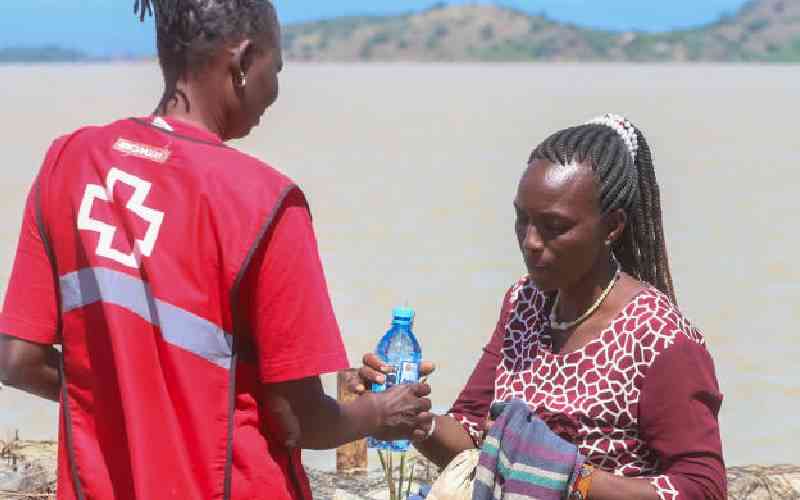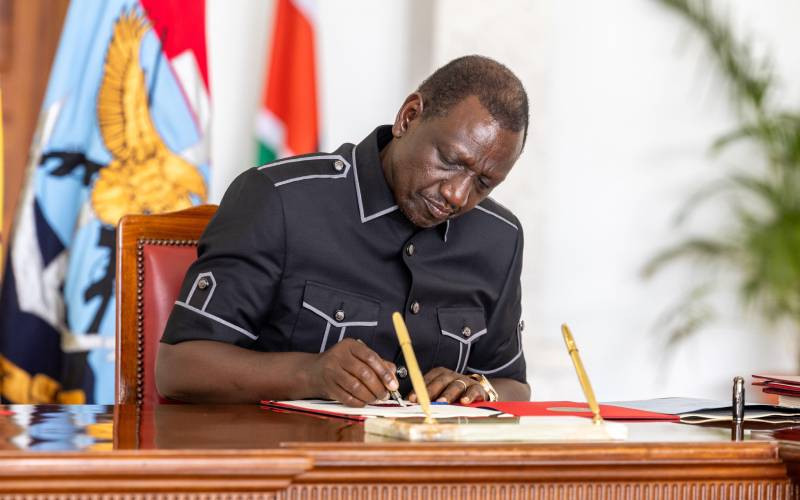 |
|
Medical personnel perform circumcision [PHOTO: FILE/STANDARD] |
By DANIEL WESANGULA
KENYA; One day as he returned home from visiting an uncle who lived far away from his village, John Eric Ouko discovered that a number of boys belonging to his age group were secretly planning to get initiated.
They thought he was too young and that knocking off his six lower teeth could expose his cowardice.
But on the day they visited the Janak for the nago ceremony, he was there to be initiated; completely unaware of the significance his undertaking would have on his life.
“I did not know why it was done but I did it…it is culturally correct…that is what our people did. I am the embodiment of our people, so that is what I did,” he says, and in deep reflection he continued; “But this other new thing…this cutting of the skin…I do not know where it has come from and where it is taking our people,”
Up until the issue of circumcision comes up, Ouko narrates the different things that make the Luo culture beautiful. From the wooing of a girl, birth, naming ceremonies and the different stages of mourning from the time of death of her husband, a woman is required to walk into her homestead naked in reverence of the departed and gets her head shaven clean after 30 days of mourning.
Through all this, he remains unfazed but the mention of circumcision unnerves him. He mentions it passively the way a man would talk about his wife’s ex-boyfriend. On the surface, there’s an air of nonchalance but inside, some kind of a bubbling bother.
Research programme
In 2006, the UNIM Project, a collaborative research programme between the Universities of Nairobi, Illinois and Manitoba, embarked on a study on the effects that Voluntary Male Medical Circumcision (VMMC) would have on the spread of HIV and Aids in Nyanza.
“Nyanza was right for the programme because it had a high HIV prevalence rate and low rates of circumcision. At the time of the study, the circumcision rate in Nyanza stood at 46 per cent while the national average was 84 per cent,” Dr Odoyo June of the Nyanza Reproductive Health Society told The Standard on Sunday.
“It was only logical we start here for maximum impact.”
In 2006 the World Health Organisation (WHO) reviewed evidence and VMMC and countries with high HIV prevalence and low circumcision rate introduced circumcision as an additional tool to fight HIV.
“There was initial resistance. They were saying they were being targeted for elimination. Politicians tried to mend fences. The Luo elders were against this… but they finally towed the line. The wave was against them,” Dr Odoyo says.
Five years later, the numbers of those who have undergone the cut have gone up, but with varying degrees of success.
For instance, although the number of males circumcised so far falls short of the targeted 850,000 by some 200,000 experts believe it remains a step in the right direction in combating HIV. But the data that initially informed this decision is lingering too long on the wrong side of the curve.
Stay informed. Subscribe to our newsletter
Earlier in the week, the 2012 update on the Kenya Aids Indicator Survey (KAIS) showed that Nyanza registered the highest number of people living with HIV despite voluntary male circumcision campaigns aimed at reducing HIV spread. Uncircumcised men are five times more at risk of contracting the disease compared to their circumcised counterparts. For children aged between 18 months and 14 years, 104,000 were found to be HIV positive, with 42,640 being diagnosed prior to the survey.
The KAIS survey also shows that widows and widowers were more prone to infection than the married and those living with partners. The lowest prevalence was among the single while the highest infections were among married couples.
Of most concern was the shift in the number of infections across different age groups. In 2007 the highest cases of infection were recorded among those aged between 25 and 34 years, the 2012 study shows that prevalence is highest among those aged between 45 and 54 years.
“Those recording the high HIV infection rates seldom come forward. Maybe because of apathy or just a general reluctance,” Dr Odoyo says. This particular group could also be the one holding on to age-old traditions.
Seated under a line of seven framed accounting certificates of different sizes, Ouko maintains that circumcision should not even be tolerated when talking about the Luo.
“We have our own thing. We have our own pride and standards to maintain. This thing is Western and will be of no use to us,” he says.
His English is impeccable.
He takes time when enunciating words. He is London educated but remains schooled in the ways of his people. Only a road, a bunch of statistics and a stubborn clinginess to tradition separates his office at the Ofafa Jericho Social Hall and Lumumba clinic where tens of young men troupe to get the cut at Dr Odoyo’s.
A less than a ten-minute matatu ride from Lumumba is the Kisumu Town main bus terminus. Opposite it is the Yellow Line shop where a group of young men chat animatedly about whether getting circumcised can be termed an insult to the founders of the Luo Nation.
Milton Orengo, 33, publicly acknowledges that he is circumcised and believes this state is partly responsible for his health status.
“Maybe if I had remained as before, I may have become sick, but I am okay,” he says. He has never tested to know his status.
“But my wife tests regularly so I know I am safe,” he says.
An attempt to talk about discordance among sexually active couples is brushed aside as an allusion to his wife’s infidelity. No further talk on the subject is tolerated.
Seven of the nine men at Yellow Line say they plan to be circumcised but don’t know when. The other two, including Milton, have had the cut. The second one is Kalenjin.
“As far as things stand now, I am healthy and have never had any problems in that ‘department’ so why fix something that is not broken?” asks one of them. With his remarks, the conversation seamlessly flows into the politics of the day.
An attempt to reintroduce the topic is met with rebuke. I am told that is enough for the day.
“You know Kisumu has become more tolerable nowadays. Two years ago, if you had started that conversation somewhere other than at a health center, people would probably have roughed you up,” Milton warns.
As he rushes across the road to get onto a matatu and demands a “squad” (free ride) one is left wondering rather nostalgically, if when called upon, he will have it in him to tell his son why he, unlike his grandfather, does not miss the six lower teeth and then provide an alternative rite of passage.
Ouko’s leathery face seems immune to the humid Kisumu heat. No bead of sweat can be spotted on his brow. He has fought many battles and like an experienced general, is wise enough to know and acknowledge when victory is out of reach. And just like the old layers of paint covering the walls of his office, he understands the values he has lived with for all his years are falling off one after the other.
“I wish times were different. But I know I am fighting a war that was lost by a different generation of warriors. It was lost when our fathers allowed the church onto our land,” he says as he smacks his lips.
His initiation gap is no more. Where there once was a gap of missing teeth now rests a new set of dentures, methodically put in place by a skilled dentist.
He says the only way he can accept circumcision was if science proves that it protects against HIV.
“One hundred per cent protection!” he says with finality, “If not, forgets it.”
Many in his age are at a cross road. There is the sense of identity, and belonging derived from hanging on to cultural practices.
But there is also the cold, hard compelling evidence that researchers like Dr Odoyo churn out on daily basis. There can only be one winner in this confrontation. But the question remains, what more collateral damage has to be tolerated before the victor emerges and the loser accepts and moves on.
“Numbers don’t lie. We will win this perception war through science,” Dr Odoyo says.
 The Standard Group Plc is a
multi-media organization with investments in media platforms spanning newspaper
print operations, television, radio broadcasting, digital and online services. The
Standard Group is recognized as a leading multi-media house in Kenya with a key
influence in matters of national and international interest.
The Standard Group Plc is a
multi-media organization with investments in media platforms spanning newspaper
print operations, television, radio broadcasting, digital and online services. The
Standard Group is recognized as a leading multi-media house in Kenya with a key
influence in matters of national and international interest.
 The Standard Group Plc is a
multi-media organization with investments in media platforms spanning newspaper
print operations, television, radio broadcasting, digital and online services. The
Standard Group is recognized as a leading multi-media house in Kenya with a key
influence in matters of national and international interest.
The Standard Group Plc is a
multi-media organization with investments in media platforms spanning newspaper
print operations, television, radio broadcasting, digital and online services. The
Standard Group is recognized as a leading multi-media house in Kenya with a key
influence in matters of national and international interest.









